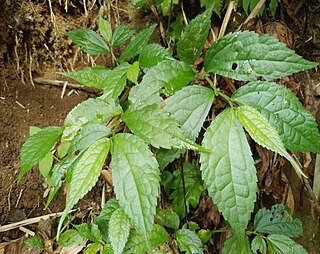
Pilea pumila, commonly known as clearweed, Canadian clearweed, coolwort or richweed, is an herbaceous plant in the nettle family (Urticaceae). It is native to Asia and eastern North America, where it is broadly distributed.

Cussonia is a genus of plants of the family Araliaceae, which is native to the Afrotropics. It originated in Africa and has its center of distribution in South Africa and the Mascarene Islands. Due to their striking habit, they are a conspicuous and easily recognizable group of plants. Their genus name commemorates the botanist Pierre Cusson. The Afro-Malagasy and Asian Schefflera, and Afrotropical Seemannaralia genera are related taxa that share several of its morphological characteristics, among which the leaves borne on the end of branches, inflorescences carried on terminal branches or stems, and reduced leaf complexity in developing inflorescences.
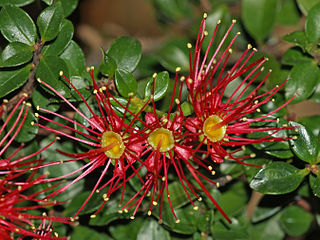
Metrosideros carminea is a forest liane or vine that is endemic to New Zealand. It occurs in coastal and lowland forest from Te Paki in the north of the North Island south to Māhia Peninsula and Taranaki. It is one of a number of New Zealand Metrosideros species which live out their lives as vines, unlike the northern rata (M.robusta), which generally begins as a hemi-epiphyte and grows into a huge tree.

Urera is a genus of flowering plants in the nettle family, Urticaceae. It has a pantropical distribution.
Epidendrum parviflorum is a small-flowered reed-stemmed Epidendrum orchid found in the montane tropical wet forests of Bolivia, Ecuador, and Amazonas, Peru.
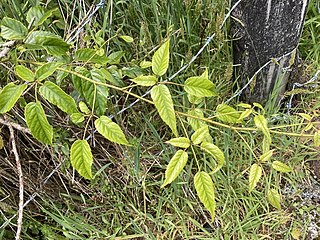
Rubus cissoides, commonly called bush lawyer or tātarāmoa in te reo Māori, is a species of flowering plant in the family Rosaceae, endemic to New Zealand. Alan Cunningham described R. cissoides in 1839. Plants of this species of are perennial scrambling vines with compound leaves with 3-5 leaflets each up to 15 cm long, reddish prickles on the branches, white flowers from September to November and red berries from December to April. The conservation status of R. cissoides is Not Threatened, it is widespread on all three main islands of mainland New Zealand, and it has been used by Māori as food, medicines and construction materials.

Vanilla polylepis is a climbing orchid species in the plant family Orchidaceae. It is native to tropical Africa, with a range spanning the width of the continent, from Kenya to Angola. It grows in high-altitude evergreen and swamp forests between 1,200–1,500 m (3,900–4,900 ft) and is often found growing on trees bordering rivers and waterfalls. Plants produce bright green, fleshy stems, 10–12 mm (0.39–0.47 in) in diameter, with large, glossy leaves. White, aerial roots form on the stems allowing the orchids to attach themselves to trees for support. As with many orchids, they produce showy flowers, which in the case of V. polylepis are white and yellow with a pink to maroon blotch. This differentiates them from similar species. They have seedpod-like fruits, called capsules, which produce a distinctive aroma as they dry. They are closely related to the well-known species Vanilla planifolia, whose seed pods are used commercially in the production of vanilla flavouring.
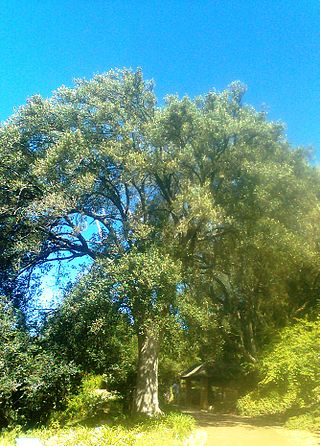
Kiggelaria africana is a large, robust, low-branching African tree, and is currently the only accepted species in the genus Kiggelaria.

Tragia durbanensis, the stinging nettle creeper, is a twining herb in the family Euphorbiaceae, with a restricted distribution in southern Africa. There are some 150 species in the genus Tragia.
Buddleja bullata is a variable species endemic to the Andes, from Venezuela south through Colombia and Ecuador to Peru, at elevations of 1,800–3,600 m, where it grows on stream beds and in the remnants of montane forest. The species was first described and named by Kunth in 1818.
Buddleja parviflora is large dioecious shrub or small tree endemic to much of upland Mexico north of the Isthmus of Tehuantepec, in forests at elevations of 750 – 3500 m. The species was first named and described by Kunth in 1818.

Urera baccifera is a species of flowering plant in the nettle family known by many common names, including scratchbush, ortiga brava, pringamoza, mala mujer, chichicaste, nigua, guaritoto, ishanga, manman guêpes, and urtiga bronca. It is native to the Americas from Mexico through Central America into South America, as well as the Caribbean.
Buddleja jinsixiaensis is a newly discovered species endemic to Shaanxi, China, where it grows in the Jinxia Grand Canyon at an elevation of c. 1,200 m. Two specimens were found, one in Quercus forest, another on a rocky slope, by a team led by Renbin Zhu in May 2013.

Allophylus decipiens (E.Mey.) Radlk., commonly known as the bastard taaibos, is a multi- or single-stemmed, small, evergreen tree about 3–4 m in height occurring in coastal forest, fringe forest and thickets, and wooded ravines and streams. Found up to 800 m in the southern coastal regions of the Cape Province, KwaZulu-Natal, Eswatini, along the escarpment forest of Mpumalanga, including Soutpansberg and in Mozambique. There are some 219 species in the genus of Allophylus.

Marantochloa purpurea is a species of plant in the family Marantaceae. It is found in tropical Africa, where its natural habitat is moist lowland forest. The leaf stems are used for various purposes including making string, baskets, mats and traps and the leaves are used for thatching, and for wrapping objects.

Haumania liebrechtsiana is a species of plant in the family Marantaceae. It grows as an understorey herb or climber in tropical forests in Central Africa. The leaves and shoots are eaten by gorillas and chimpanzees, and the leaves and stems have traditional uses.
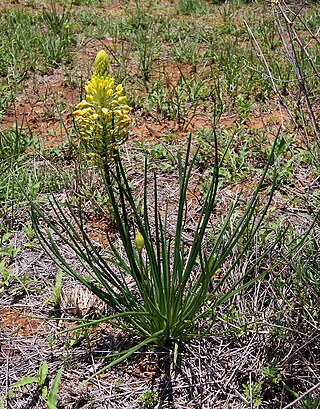
Bulbine abyssinica is a species of plant in the genus Bulbine, from eastern and southern Africa.

Pseudovanilla foliata, commonly known as the great climbing orchid, is a plant in the orchid family native to Queensland, New South Wales, and New Guinea. It is a terrestrial orchid with a vining vegetative habit, climbing by means of adventitious roots produced at nodes. Its leaves are reduced, and the species is considered to be at least partially mycoheterotrophic.
Strychnos icaja is a species belonging to the plant family Loganiaceae, native to West Tropical Africa. It is a very large, tropical rainforest liana which may attain a length of 100 m (330 ft).

Nolina beldingii is a species of perennial flowering plant in the family Asparagaceae known commonly as the Cape nolina or Belding's beargrass. It is an arborescent monocot growing up to 7 metres (23 ft) high, with fissured bark on a trunk topped with leaf rosettes. The narrow leaves are up to 1.15 m (3.8 ft) long, and are used as thatching by local peoples. This species is endemic to Baja California Sur in Mexico, where it grows only in the highest reaches of the Sierra de la Laguna. It is found primarily in oak forests at elevations over 1,000 m (3,300 ft) along rocky granite outcrops.




















